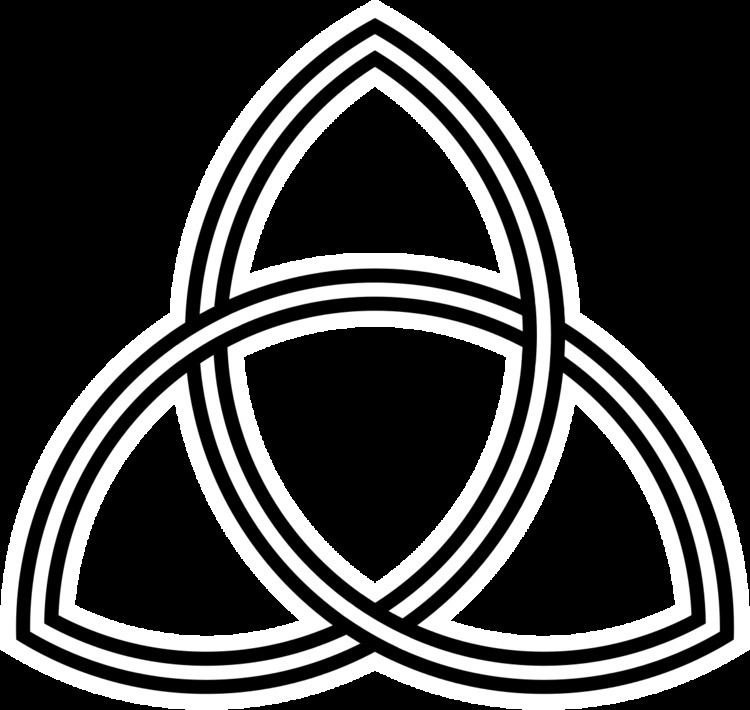 | ||
Triquetra (/traɪˈkwɛtrə/; Latin tri- "three" and quetrus "cornered") originally meant "triangle" and was used to refer to various three-cornered shapes. It has come to refer exclusively to a particular more complicated shape formed of three vesicae piscis (the leaf-like shape in between two equal diameter circles when both centers are on the circumference of the other circle), sometimes with an added circle in or around the three lobes. Also known as a "trinity knot" when parallel doubled-lines are in the graph, the design is used as a religious symbol adapted from ancient Celtic images by Christianity. It is similar to Odin's symbol, the valknut.
Contents
Celtic art
The triquetra is often found in insular art, most notably metal work and in illuminated manuscripts like the Book of Kells. It is also found in similar artwork on Celtic crosses and slabs from the early Christian period. The fact that the triquetra rarely stood alone in medieval Celtic art has cast reasonable doubt on its use as a primary symbol of belief. In manuscripts it is used primarily as a space filler or ornament in much more complex compositions, and in knotwork panels it is a design motif integrated with other design elements. This widely recognised knot has been used as a singular symbol for the past two centuries by Celtic Christians, pagans and agnostics as a sign of special things and people that are threefold.
Japanese use
The triquetra has been a known symbol in Japan called Musubi Mitsugashiwa. Being one of the forms of the Aryan Iakšaku dynasty signs, it reached Japan with the dynasty's Kāśyapīya spreading technology and Buddhism via Kingdom of Khotan, after which the Japanese sword katana is called, China and Korea.
Germanic paganism
The triquetra has been found on runestones in Northern Europe and on early Germanic coins. It presumably had pagan religious meaning and it bears a resemblance to the valknut, a symbol associated with Odin.
Christian use
The symbol has been used in Christian tradition as a sign of the Trinity (Father, Son and Holy Spirit), especially since the Celtic revival of the 19th century. When modern designers began to display the triquetra as a stand-alone design, it recalled the three-leafed shamrock which was similarly offered as a Trinity symbol by Saint Patrick. have also suggested that the triquetra has a similarity to the Christian Ιχθυς symbol. The triquetra has been used extensively on Christian sculpture, vestments, book arts and stained glass. It has been used on the title page and binding of some editions of the New King James Version.
A very common representation of the symbol is with a circle that goes through the three interconnected loops of the triquetra. The circle emphasises the unity of the whole combination of three forces. It is also said to symbolise God's love around the Holy Trinity.
Modern use
In contemporary Ireland, it is traditional for lovers to exchange jewelry such as a necklace or rings signifying their affection. The triquetra, also known as a "trinity knot", is often found as a design element is popular Irish jewelry such as claddaghs and other wedding or engagement rings.
Neopaganism
It is difficult to date the exact origin of the Irish triquetra, and whether it was first used in a Christian or pagan context; the distinctive interlace/knotwork artistic style did not fully develop until ca. the 7th century AD, but the triquetra is the simplest possible knot. Celtic pagans, or even neopagans who are not of a Celtic cultural orientation, may use the triquetra to symbolise a variety of concepts and mythological figures.
Due to its presence in insular Celtic art, Celtic Reconstructionists use the triquetra either to represent one of the various triplicities in their cosmology and theology (such as the tripartite division of the world into the realms of Land, Sea and Sky), or as a symbol of one of the specific Celtic triple goddesses, for example the battle goddess, The Morrígan.
Germanic neopagan groups who use the triquetra to symbolise their faith generally believe it is originally of Norse and Germanic origins.
The symbol is also sometimes used by wiccans and some new agers to symbolise the Triple Goddess, or as a protective symbol.
Popular culture
The triquetra is often used artistically as a design element when Celtic knotwork is used. Many who identify as modern Celts may use the symbol to display an identification with Celtic culture, whether they live in the Celtic Nations or the diaspora.
In brands and logos
In film
In games
In literature and publications
In music
In television
Geometry
Topologically, the interlaced form of the plain triquetra is a trefoil knot.
